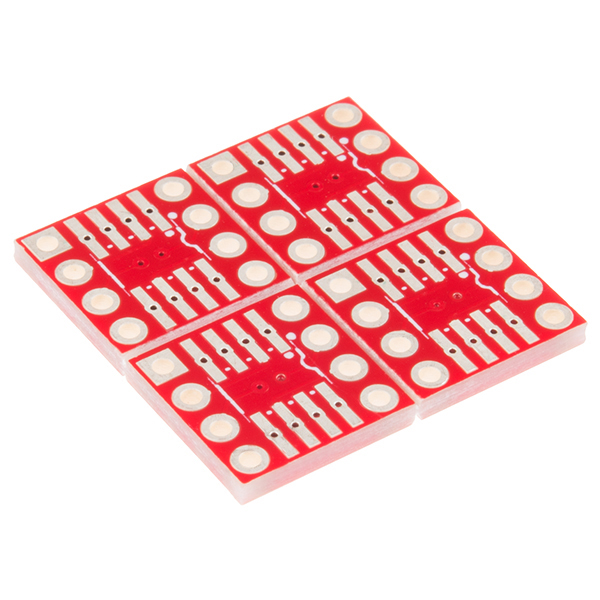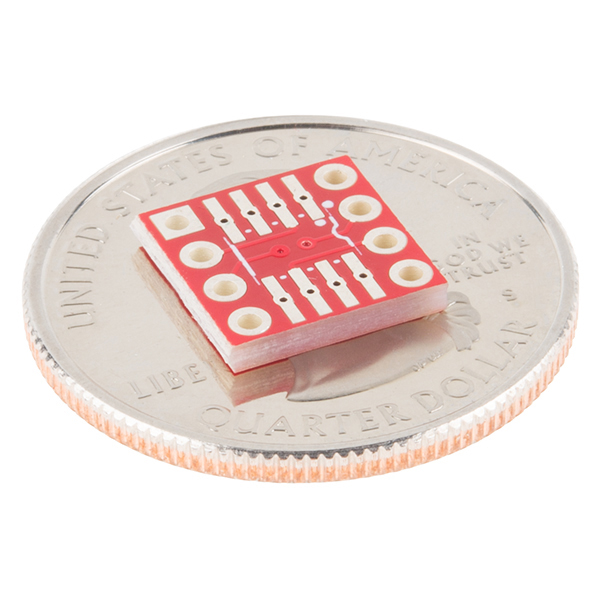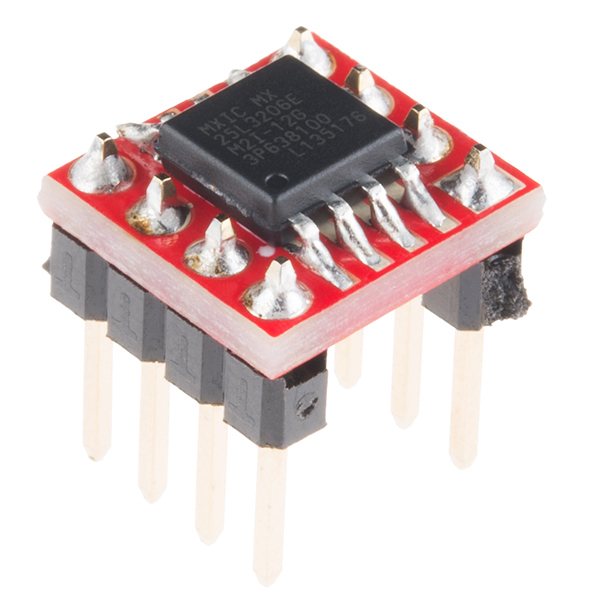SparkFun SOIC to DIP Adapter - 8-Pin
The SparkFun 8-Pin SOIC to DIP Adapter is a small PCB that lets you adapt SOIC packages into a DIP footprint. These tiny boards are useful for modding and upgrading devices that use 8-pin DIP ICs, when the upgraded IC is only available in a SOIC footprint. You can also use these adapters for prototyping by making SOIC packages compatible with solderless breadboards.
This version of the SparkFun SOIC to DIP Adapter adapter comes as a small array of four boards. We did this because if you’re adapting one chip, you are more than likely to adapt another. The PCBs easily snap apart from each other, thanks to two crossing v-scored lines.
- Schematic
- Eagle Files
- Hookup Guide
- GitHub (Designs Files)
SparkFun SOIC to DIP Adapter - 8-Pin Product Help and Resources
8-Pin SOIC to DIP Adapter Hookup Guide
August 13, 2015
Assembly and application of the 8-pin SOIC-to-DIP adapter.
Core Skill: Soldering
This skill defines how difficult the soldering is on a particular product. It might be a couple simple solder joints, or require special reflow tools.
Skill Level: Noob - Some basic soldering is required, but it is limited to a just a few pins, basic through-hole soldering, and couple (if any) polarized components. A basic soldering iron is all you should need.
See all skill levels
Comments
Looking for answers to technical questions?
We welcome your comments and suggestions below. However, if you are looking for solutions to technical questions please see our Technical Assistance page.
Customer Reviews
4.6 out of 5
Based on 14 ratings:
1 of 1 found this helpful:
The absolute best DIP adapter
Very high quality board. Very Easy to snap apart. Very easy to solder ! Recommend machine pin interface. I've tried others but this SparkFun Dip adapter is the best !
Very useful adapter
Allows me to use many products I would otherwise be unable to incorporate in my projects
Perfect for the LM4881...
Was prototyping with a LM4881 chip, and this was just the ticket to help breadboard that amp chip. Perfect!
Too wide for SOIC-8
These templates are too wide for SOIC-8. Do not use for narrow profile.
Excellent Little Boards
These little boards have so far worked perfectly for letting me use some interesting SOIC-8 chips even though I don't have a reflow oven. I especially like the vias in the center of the pads. They really help contain excess solder so you don't form junctions when soldering by hand. Great design and implementation!
Perfect
Just what I needed. Thanks!
Very easy to use
Easy to use and allows for breadboard testing. I'm not great with soldering small SOIC devices yet but even I was able to work just fine with this adapter.
Nice board. But several weeks for delivery.
Arrived too late for me to use it in my Maker Faire (NY 2017) project. Used to McMaster Carr's overnight deliveries ....this was not the case with Sparkfun. So some of the fun went missing.
SOIC to DIP adapters
Great little adapters that allow adaption of service 8 pin surface mount to 8 pin DIP. Easy to use and work well
Just what I needed for my amp upgrade
I am upgrading my fender frontman 15r, one of the things I am doing is replacing the op amps on the circuit board. All the dual op amps were eight pin dips. So first I removed the old op amps, and installed dip sockets so I could try out different op amps seeing which set I would like the most. Some of the more high end op amps don't have a dip package, sparkfun was the first place that showed up as having the adapter PCB. They work like a charm.
Exactly right.
I bought these to allow use of SMT devices (2 8-pin SOIC FETs and a diode) in a solderless breadboard application for EE student son - neither of us are trained in SMT soldering. These adapters fit the bill perfectly. I used a digital microscope to solder the chips down to the board (my eyes are 64 years old!) then I soldered the board to two 4-pin headers (which could have been provided for that fifth star) by using the solderless breadboard as a jig to hold them in position and vertical. The four units broke a part from each other perfectly - excellent idea to provide them in fours, and the mfr did a nice job on the scoring. I'll be buying more of these, for sure, an strongly recommend them. Only neg? A bit pricey, considering they're bare boards: they cost almost as much as the chips that went on them. One recommendation for rev 2: the 90 degree rotation of the chip vs. the pins means you have to think a bit about orientation, so please make the silk screen notch for the 1&8 end a little bolder, as it's a little hard to see for a cross-check once assembled. I also used to 20-pin version too, for a buck converter chip used in the project: that worked well too, though I had to drill a hole in the board to solder a wire to the pin 21/heatsink pad.
good quality and did the job well
Nice little work saver
Next project will probably use a little instrument amplifier only available in SOIC. This board made it easy to do a breadboard first.
Good way if you want to buy new Winbond SPI ROMs and have them be DIP compatible
This is a good product if you need to get new DIP-compatible Winbond ROMs from a reputable vendor. When ordering Winbond's SPI chips from places like Digikey, I've found that you can't really get the DIP variants of their chips anymore. Now I've had a few occasions when I've ran into counterfeit chips when ordering various UART-to-RS232 boards and such from places like Ebay, and those were seemingly the only place I could find the chips I wanted in DIP form. That wasn't going to fly, so I bought some of these with some other stuff I was ordering, soldered some 8 MiB Winbond SOIC chips I had already ordered from Digikey to these boards, and I had a few as-close-as-possible brand-new replacement BIOS chips for the motherboards I was trying to build coreboot-based firmware for. That way, if I blew up a chip by putting it in the programmer the wrong way, I would have a direct replacement on hand that I could put in it's place.
One thing I can say about soldering headers on to them, is if you want to use the completed assemblies in sockets, I would highly recommend not using normal headers with them. You will ruin the DIP socket for normal chips and you will have to replace the socket if you ever want to put a normal chip in the place of an assembly. I use swiss machine headers and they seem to work fine.







The full dimensions for this board are available through the GitHub repo.